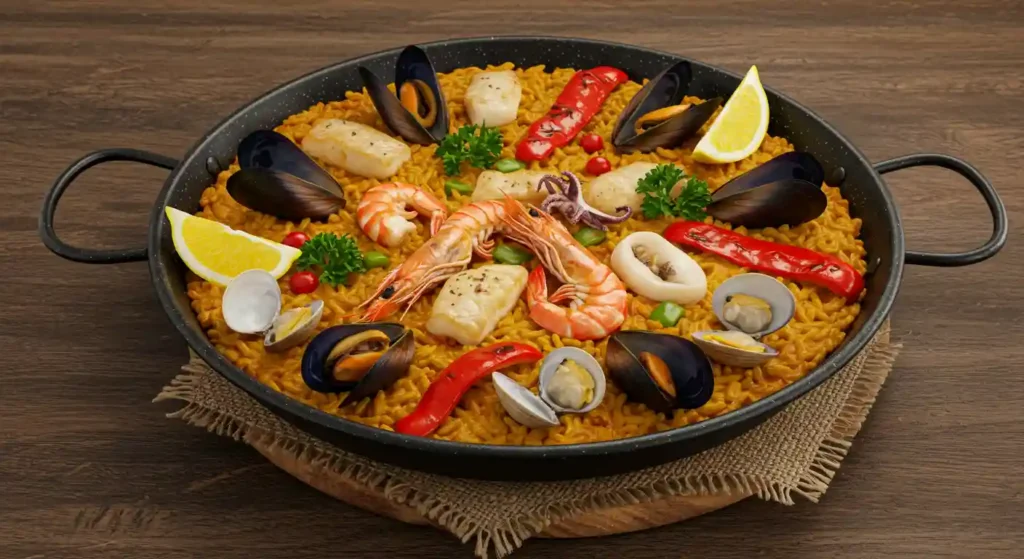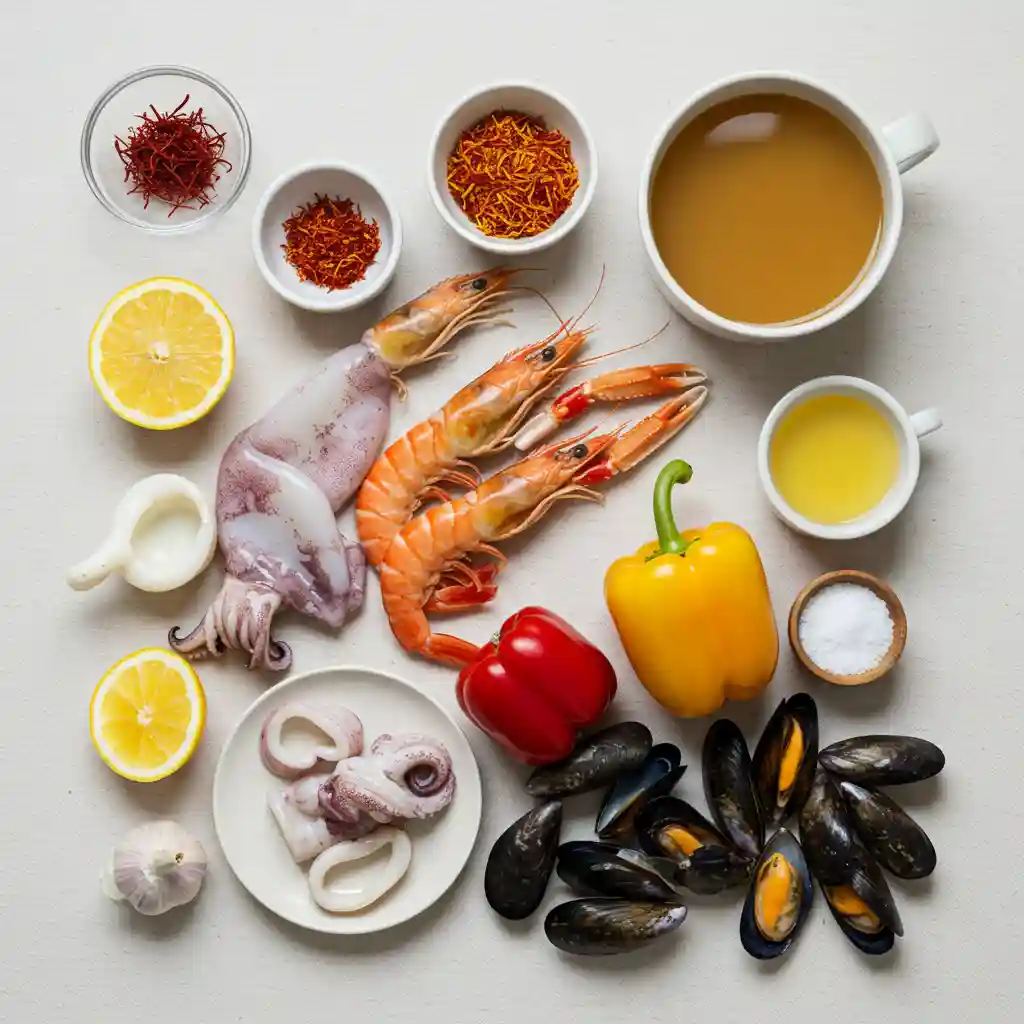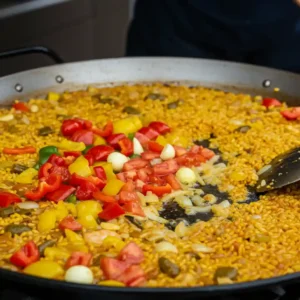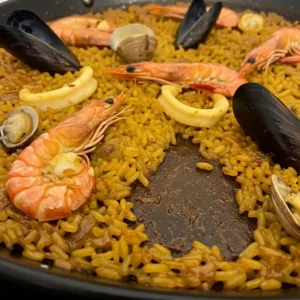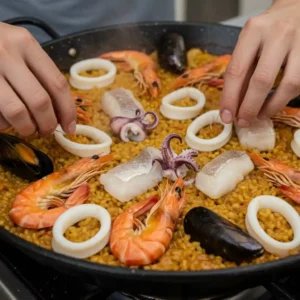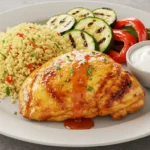Are you craving the distinctive flavors of Spain’s most iconic dish? Look no further than this authentic receta de paella de mariscos (seafood paella recipe) that brings Mediterranean magic straight to your kitchen. As a culinary tradition dating back centuries, paella combines the bounty of the sea with saffron-infused rice to create a dish that’s as visually stunning as it is delicious.
In this comprehensive guide, you’ll discover everything you need to know about creating the perfect paella de mariscos tradicional at home—from selecting the freshest ingredients to mastering that coveted socarrat (the crispy bottom layer that connoisseurs prize). Whether you’re a beginner or an experienced cook looking to refine your technique, this step-by-step recipe will help you create a memorable Spanish feast for family and friends.
Table of Contents
The Rich History Behind Seafood Paella
Before diving into our receta de paella de mariscos, it’s worth understanding the cultural significance of this beloved dish. Originating in Valencia, Spain, paella was traditionally a farmer’s meal cooked over an open fire in the fields. The original Valencian paella contained ingredients like rabbit, snails, and local vegetables—whatever was available.
The coastal variation that became paella de mariscos emerged naturally as fishermen adapted the dish using their daily catch. Today, seafood paella is enjoyed worldwide and represents Spanish cuisine at its finest—a celebration of regional ingredients transformed by simple yet precise cooking techniques.
The word “paella” actually refers to the wide, shallow pan in which the dish is cooked, not the food itself—though over time, the name has come to represent both the cooking vessel and the delicious rice dish we know and love.
Essential Ingredients for Paella de Mariscos
The secret to an exceptional receta de paella de mariscos lies in using high-quality, fresh ingredients. Here’s what you’ll need to serve 4-6 people:
Rice and Base Ingredients:
- 2 cups Bomba or Calasparra rice (Spanish short-grain rice)
- 4-5 cups fish stock or seafood broth
- 1 large pinch of saffron threads (about ¼ teaspoon)
- 3 tablespoons extra virgin olive oil
- 1 large onion, finely diced
- 4 garlic cloves, minced
- 1 red bell pepper, diced
- 2 medium tomatoes, grated or finely chopped
- 1 teaspoon smoked paprika
- ½ teaspoon cayenne pepper (optional, for heat)
- Salt and freshly ground pepper to taste
Seafood Components:
- 12 large shrimp or prawns, shell-on
- 12 mussels, cleaned
- 12 clams, cleaned
- 8 oz squid, cleaned and sliced into rings
- 8 oz firm white fish (like cod or sea bass), cut into chunks
Garnish:
- Fresh lemon wedges
- ¼ cup fresh parsley, chopped
- 1 roasted red pepper, sliced into strips
Chef’s Tip: When shopping for ingredientes para paella de mariscos, always prioritize freshness, especially with seafood. The flavor of your paella depends greatly on the quality of your ingredients!
Essential Equipment for Perfect Paella
To prepare an authentic paella de mariscos receta fácil, you’ll need some specific equipment:
- Paella pan (paellera): A wide, shallow pan typically 13-17 inches in diameter for 4-6 servings
- Heat source: Ideally a gas burner that can accommodate the size of your pan
- Wooden spoon: For stirring without damaging the pan
- Measuring cups and spoons: For precise ingredient measurements
- Small mortar and pestle: For crushing saffron (optional)
- Tongs: For arranging seafood
If you’re new to paella making, don’t worry if you don’t have a specialized pan. A wide, shallow skillet can work as a substitute, though traditionalists might argue that it won’t produce the authentic socarrat.
Step-by-Step Receta de Paella de Mariscos
Follow these detailed instructions to create your paella de mariscos paso a paso:

1. Prepare Your Ingredients and Workspace
- Measure all ingredients and have them ready before starting.
- Clean all seafood thoroughly.
- Position your paella pan on the heat source, ensuring it sits level.
2. Create the Flavor Base (Sofrito)
- Heat olive oil in your paella pan over medium heat.
- Add the diced onion and cook until translucent (about 5 minutes).
- Add the minced garlic and cook for 1 minute until fragrant.
- Add the diced bell pepper and cook for another 3-4 minutes until softened.
- Add the grated tomatoes and cook for 5-7 minutes until the mixture darkens and thickens.
- Stir in the smoked paprika and cayenne (if using).
3. Infuse the Broth
- In a separate pot, warm your fish stock or seafood broth.
- Crush the saffron threads between your fingers or in a mortar and pestle.
- Add the saffron to the warm broth and let it infuse for at least 5 minutes.
4. Cook the Rice
- Spread the sofrito evenly across the bottom of the paella pan.
- Add the rice and stir briefly to coat it with the sofrito (no more than 1-2 minutes).
- Pour in the saffron-infused broth.
- Bring to a gentle boil, then reduce to a simmer.
- Season with salt and pepper to taste.
- Important: From this point on, do not stir the rice! This is crucial for developing the socarrat.
5. Add the Seafood
- After the rice has been cooking for about 10 minutes, arrange the seafood on top:
- Place the fish pieces evenly around the pan
- Add the squid rings
- Position the shrimp/prawns decoratively
- Nestle the clams and mussels into the rice, hinge-side down so they can open upward
- Continue cooking for another 10-15 minutes until:
- The rice is tender but still has a slight bite
- Most of the liquid has been absorbed
- The seafood is cooked through (mussels and clams should be open)
6. Develop the Socarrat
- In the last few minutes of cooking, increase the heat slightly to medium-high.
- Listen for a gentle crackling sound, indicating the socarrat is forming.
- Be vigilant to prevent burning—you want a crisp, caramelized layer, not a burnt one.
- Once you detect a toasted aroma and hear the crackling, remove from heat.
7. Rest and Garnish
- Cover the paella with a clean kitchen towel or aluminum foil.
- Let it rest for 5-10 minutes before serving.
- Garnish with lemon wedges, chopped parsley, and roasted red pepper strips.
- Bring the entire pan to the table for a dramatic presentation!
Expert Insight: Traditional Spanish cooks judge the doneness of paella by smell and sound rather than by appearance or timing. Trust your senses!
Common Variations on the Classic Receta de Paella de Mariscos
While the traditional receta de paella de mariscos is a seafood lover’s dream, several popular variations exist:
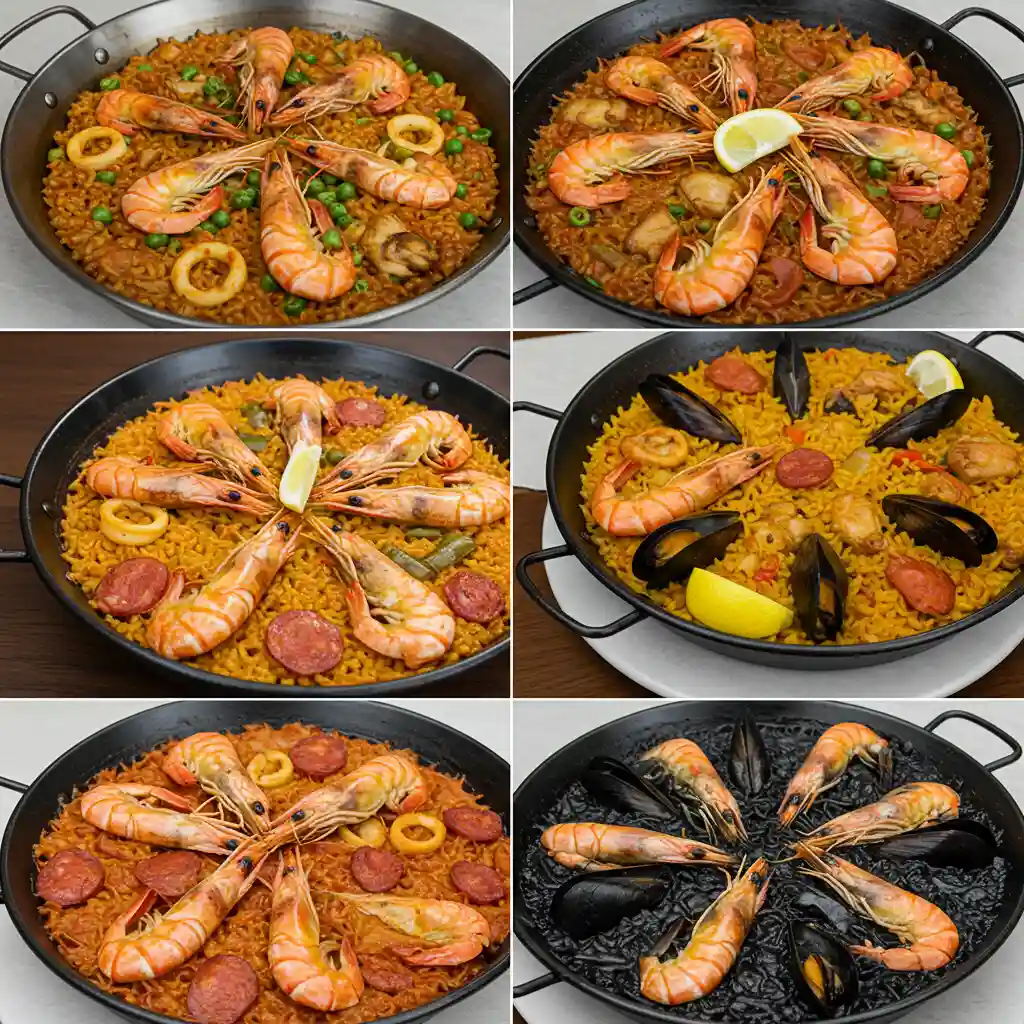
Mixed Paella (Paella Mixta)
Combines seafood with chicken and Spanish chorizo for a land-and-sea experience. Simply add:
- 2 chicken thighs, cut into pieces and browned before starting the sofrito
- 4 oz Spanish chorizo, sliced and added with the chicken
Black Paella (Arroz Negro or Paella Negra)
Features squid ink for a dramatic black color and rich flavor:
- Add 1-2 tablespoons of squid ink to the broth before adding to the rice
- Increase the amount of squid in the recipe
- Often served with alioli (garlic mayonnaise) for contrast
Vegetarian Paella
Replace seafood with:
- Artichoke hearts
- Asparagus
- Green beans
- Mushrooms
- Roasted red peppers
- Extra firm tofu (non-traditional but works well)
Pro Tips for the Mejor Receta de Paella de Mariscos
To elevate your paella de mariscos receta fácil to restaurant quality:
- Rice Selection Matters: Bomba rice is traditional and absorbs more liquid while maintaining its structure. If unavailable, Arborio (risotto rice) can substitute but will yield a creamier texture.
- Perfect Your Socarrat: The crispy bottom layer is considered the crown jewel of paella. Listen for the gentle crackling sound in the final minutes of cooking—this indicates the socarrat is forming.
- Don’t Overcrowd the Pan: Paella should be cooked in a thin layer. The rice layer should ideally be no more than ½ inch thick.
- Resist the Urge to Stir: Once you’ve added the rice and broth, avoid stirring to allow proper socarrat formation.
- Use Room Temperature Seafood: Cold seafood can cool your cooking surface and lead to uneven cooking.
- Consider a Paella Burner: For large paellas, a specialized burner ensures even heat distribution across the entire pan.
Nutritional Information
Per serving (based on 6 servings):
- Calories: 520
- Protein: 30g
- Carbohydrates: 52g
- Fat: 22g
- Fiber: 4g
- Sodium: 870mg
Note: Nutritional values are approximate and will vary based on specific ingredients used.
Serving and Presentation Suggestions
Enhance your receta de paella de mariscos experience with these complementary dishes and presentation ideas:
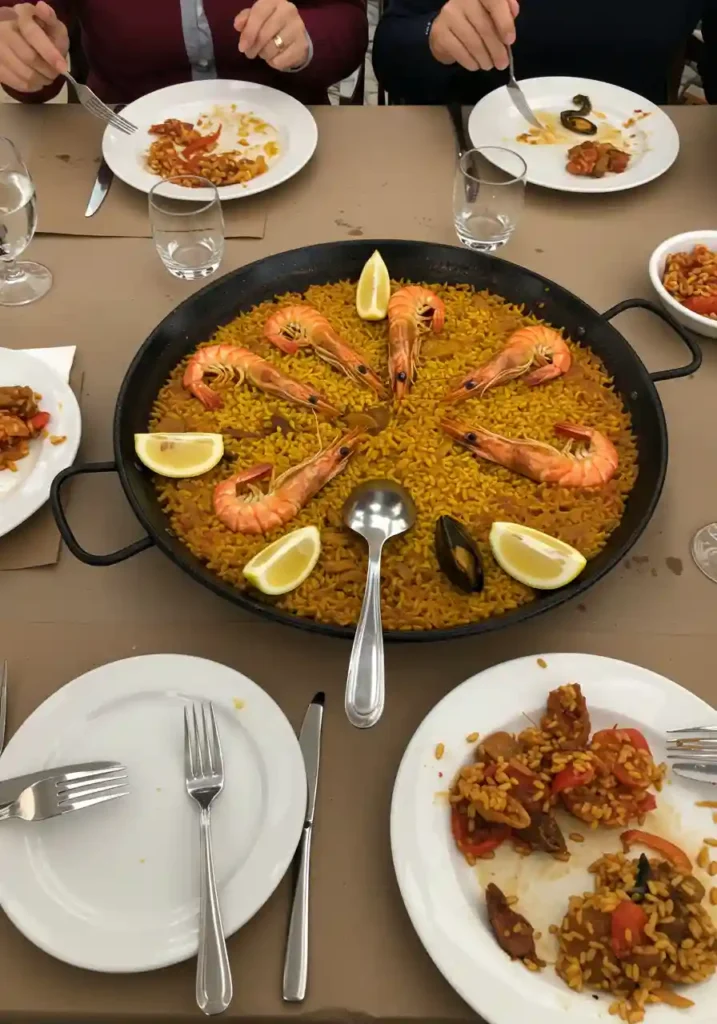
Accompaniments:
- Crusty bread: Essential for soaking up the flavorful juices
- Simple green salad: With a light vinaigrette to balance the richness
- Alioli: Traditional garlic mayonnaise for dipping seafood
- Spanish olives: As a pre-meal appetizer
Beverage Pairings:
- Fresh citrus-infused water: With lemon, lime, or orange slices
- Sparkling water with a splash of juice: Try orange or pomegranate for a Spanish-inspired flavor
- Traditional Spanish horchata: A refreshing tiger nut milk beverage
- Agua de Valencia (non-alcoholic version): Made with fresh orange juice and sparkling water
Presentation:
- Serve the paella in its cooking pan at the center of the table
- Provide separate small plates and forks for individual servings
- Include small bowls for discarded shells
- Garnish dramatically with lemon wedges and fresh herbs
Storing and Reheating Leftover Paella
While paella is best enjoyed fresh, leftover paella de mariscos tradicional can still be delicious:
- Storage: Refrigerate leftovers within two hours of cooking in an airtight container for up to 2 days.
- Reheating: Gently warm in a covered pan with a splash of water or broth to rehydrate the rice. Alternatively, portions can be microwaved covered with a damp paper towel.
- Food Safety: If leftover paella contains seafood, be extra vigilant about proper refrigeration and consume within 48 hours.
Health Considerations and Adaptations
This receta de paella de mariscos can be adapted for various dietary needs:
- Gluten-Free: Traditional paella is naturally gluten-free, but always check store-bought broths for additives.
- Low-Carb: Substitute cauliflower rice for regular rice (though this is very non-traditional).
- Seafood Allergies: Create a chicken and vegetable variation instead.
Medical Disclaimer: Shellfish is a common allergen. Ensure all guests are aware of the ingredients in your paella, particularly if serving to those with unknown dietary restrictions.
Embracing the Cultural Experience
Making paella de mariscos isn’t just about cooking—it’s about embracing Spanish culture. In Spain, paella is often cooked outdoors as a communal activity, with friends and family gathering to socialize while the dish slowly comes together.
Consider turning your paella-making into an event:
- Invite friends to help with preparation
- Play Spanish music
- Serve Spanish appetizers like pan con tomate or jamón ibérico
- Make the paella visible to guests so they can watch the process

Receta de Paella de Mariscos – Seafood Paella Recipe
Ingredients
Rice and Base Ingredients:
- 2 cups Bomba or Calasparra rice Spanish short-grain rice
- 4-5 cups fish stock or seafood broth
- 1 large pinch of saffron threads about ¼ teaspoon
- 3 tablespoons extra virgin olive oil
- 1 large onion finely diced
- 4 garlic cloves minced
- 1 red bell pepper diced
- 2 medium tomatoes grated or finely chopped
- 1 teaspoon smoked paprika
- ½ teaspoon cayenne pepper optional, for heat
- Salt and freshly ground pepper to taste
Seafood Components:
- 12 large shrimp or prawns shell-on
- 12 mussels cleaned
- 12 clams cleaned
- 8 oz squid cleaned and sliced into rings
- 8 oz firm white fish like cod or sea bass, cut into chunks
Garnish:
- Fresh lemon wedges
- ¼ cup fresh parsley chopped
- 1 roasted red pepper sliced into strips
Chef’s Tip: When shopping for ingredientes para paella de mariscos, always prioritize freshness, especially with seafood. The flavor of your paella depends greatly on the quality of your ingredients!
Instructions
Prepare Your Ingredients and Workspace
- Measure all ingredients and have them ready before starting.
- Clean all seafood thoroughly.
- Position your paella pan on the heat source, ensuring it sits level.
Create the Flavor Base (Sofrito)
- Heat olive oil in your paella pan over medium heat.
- Add the diced onion and cook until translucent (about 5 minutes).
- Add the minced garlic and cook for 1 minute until fragrant.
- Add the diced bell pepper and cook for another 3-4 minutes until softened.
- Add the grated tomatoes and cook for 5-7 minutes until the mixture darkens and thickens.

- Stir in the smoked paprika and cayenne (if using).
Infuse the Broth
- In a separate pot, warm your fish stock or seafood broth.
- Crush the saffron threads between your fingers or in a mortar and pestle.
- Add the saffron to the warm broth and let it infuse for at least 5 minutes.
Cook the Rice
- Spread the sofrito evenly across the bottom of the paella pan.

- Add the rice and stir briefly to coat it with the sofrito (no more than 1-2 minutes).
- Pour in the saffron-infused broth.
- Bring to a gentle boil, then reduce to a simmer.
- Season with salt and pepper to taste.
Important: From this point on, do not stir the rice! This is crucial for developing the socarrat.
Add the Seafood
- After the rice has been cooking for about 10 minutes, arrange the seafood on top:

- Place the fish pieces evenly around the pan
- Add the squid rings
- Position the shrimp/prawns decoratively
- Nestle the clams and mussels into the rice, hinge-side down so they can open upward
- Continue cooking for another 10-15 minutes until:
- The rice is tender but still has a slight bite
- Most of the liquid has been absorbed
- The seafood is cooked through (mussels and clams should be open)
Develop the Socarrat
- In the last few minutes of cooking, increase the heat slightly to medium-high.
- Listen for a gentle crackling sound, indicating the socarrat is forming.
- Be vigilant to prevent burning—you want a crisp, caramelized layer, not a burnt one.

- Once you detect a toasted aroma and hear the crackling, remove from heat.
Rest and Garnish
- Cover the paella with a clean kitchen towel or aluminum foil.
- Let it rest for 5-10 minutes before serving.
- Garnish with lemon wedges, chopped parsley, and roasted red pepper strips.
- Bring the entire pan to the table for a dramatic presentation!

Expert Insight: Traditional Spanish cooks judge the doneness of paella by smell and sound rather than by appearance or timing. Trust your senses!
Notes
- Calories: 520 kcal
-
Fat: 22g
- Saturated Fat: 4g
- Trans Fat: 0g
- Protein: 30g
-
Carbohydrates: 58g
- Fiber: 4g
- Sugars: 5g
- Cholesterol: 120mg
- Sodium: 870mg
- Potassium: 850mg
- Vitamin A: 15% DV
- Vitamin C: 35% DV
- Calcium: 6% DV
- Iron: 15% DVNote: Nutritional values are approximate and will vary based on specific ingredients used.
Conclusion: Mastering the Art of Paella de Mariscos
Creating an authentic receta de paella de mariscos requires attention to detail and quality ingredients, but the results are truly worth the effort. This iconic Spanish dish brings together the bounty of the sea with aromatic rice in a celebration of Mediterranean flavors that has stood the test of time.
Whether you’re cooking for a special occasion or simply wanting to expand your culinary horizons, this seafood paella recipe provides both impressive results and a rewarding cooking experience. The combination of tender rice, flavorful sofrito, and perfectly cooked seafood makes for a meal that’s sure to become a favorite in your recipe collection.
Remember that like any traditional dish, the best paella comes with practice. Each time you prepare this receta de paella de mariscos, you’ll gain more confidence and develop your own signature touch.
We’d love to hear about your paella-making adventures! Share your experiences, modifications, or questions in the comments below. And if you enjoyed this recipe, don’t forget to subscribe to our newsletter for more authentic international recipes delivered straight to your inbox.
¡Buen provecho!
FAQ: Receta de Paella de Mariscos – Seafood Paella Recipe
1. What is the best rice for making seafood paella?
The best rice for seafood paella is Bomba rice or Calasparra rice. These Spanish short-grain rice varieties absorb liquid well without becoming mushy, giving paella its signature texture.
2. Can I use regular rice instead of paella rice?
While Bomba or Calasparra rice is ideal, you can substitute Arborio rice or medium-grain rice if necessary. Avoid long-grain rice, as it doesn’t absorb flavors as well.
3. What seafood is traditionally used in paella de mariscos?
Common seafood ingredients include shrimp, mussels, clams, squid, and sometimes fish. The key is to use fresh seafood for the best flavor.
4. Do I need a special pan to cook paella?
A paella pan (paellera) is recommended because its wide, shallow shape helps cook the rice evenly and develop the crispy socarrat at the bottom. However, a large, shallow skillet can work as a substitute.
5. How do I achieve the perfect socarrat (crispy rice layer)?
To create the socarrat, cook the paella uncovered on medium-high heat for the last few minutes. Listen for a crackling sound but avoid stirring. Be careful not to burn it!
6. Can I make paella without saffron?
Saffron adds authentic flavor and color to paella, but if unavailable, you can use turmeric or paprika as a substitute. However, the taste won’t be exactly the same.
7. Can I prepare seafood paella in advance?
Paella is best served fresh, but you can prep ingredients ahead of time. If reheating, do so in a pan over low heat to maintain texture rather than using a microwave.
8. Is seafood paella gluten-free?
Yes, traditional paella de mariscos is naturally gluten-free, as it contains rice, seafood, broth, and spices without any wheat-based ingredients.
9. What is the best way to serve seafood paella?
Serve paella straight from the pan, garnished with fresh lemon wedges for an extra burst of flavor. It pairs well with a simple green salad or crusty bread.
10. Can I add chorizo to seafood paella?
Traditional Receta de Paella de Mariscos does not include chorizo, as it is a seafood-based dish. However, some variations mix meats like chicken or chorizo, but this is more common in Paella Mixta.

